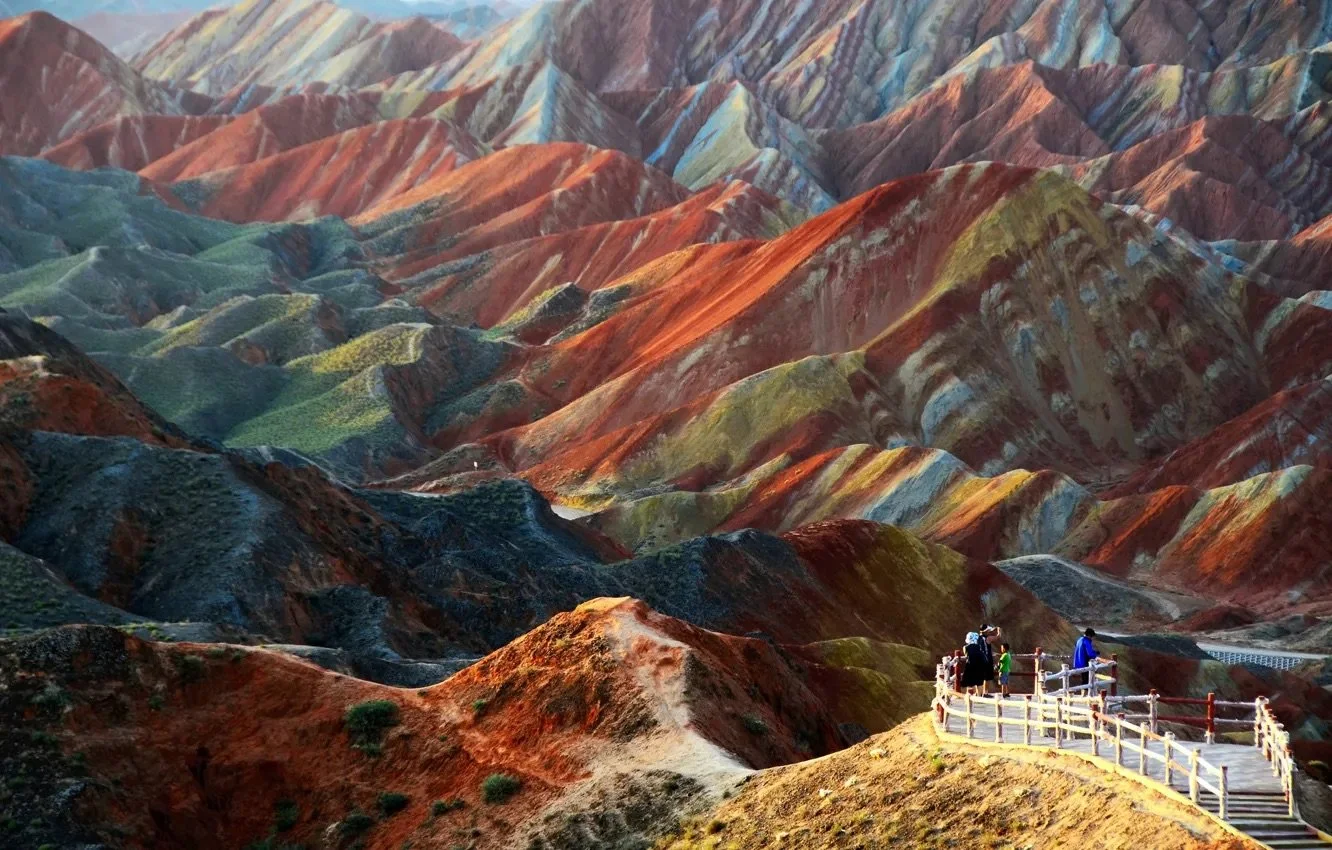Eons of time and colossal tectonic plates have shaped China's most colorful national treasure.
Rainbow Mountains in Zhangye Danxia National Landform Geological Park. Alonso Brosmann. CC BY-NC 4.0
Over millions of years of natural geological processes, China’s Rainbow Mountains have developed into a “geological wonder of the world.” Often compared with Canada’s Rainbow Range and Peru’s Vinicna Mountain, Gansu province’s Rainbow Mountains are a tourist attraction located in the Zhangye Danxia Landform Geological Park. Approximately 200 square miles in area, the Geological Park is located just outside of Zhangye City in the Hexi Corridor of Gansu. For the mountains, there are two scenic areas: Qicai (“Seven Colors”, where the Rainbow Mountains are located), and Binggou (“Ice Ravine"). Binggou is an area located near the mountains, offering more views and landscapes for tourists to explore.
The colorful layering of the Zhangye mountains was created through sediment deposits and erosion over time. Telangana Today explains that, “The colorful landscapes were created by sandstone and minerals being layered atop each other over years with tectonic plates shifting, creating angled, painted layers across the rock formation and sandstone rolling hills.” Geologist Trevor Nace discusses how, before the brilliant colors visible today could be seen, the sedimentary rock that composes the Rainbow Mountains had to be pushed up by the collision of plate tectonics and an outer layer of siliciclastic rock had to be worn down The topmost layers, which were less fantastic, were shed over time through rain, wind and other elements. Nace accredits the vibrance of the colors to the different levels of iron in the different layers, with the rainbow formations just “some examples of how sandstones can be altered in coloring during diagenesis,” the recombination or rearrangement of constituents.
The Operational Land Imager (OLI) on the Landsat 8 satellite in outer space captured images of the mountains that allowed scientists to observe their mineral content. NASA notes that, “The reds and browns of exposed sandstones and other sedimentary rocks poke out from the range’s northern foothills, where the mountains meet a flat basin to the north known as the Hexi corridor.” Such studies of the mountains contribute to a growing understanding of geological processes, the different shades of the Rainbow Mountains all representing different levels of erosion, iron, and other elements and processes.
Buildings in the Zhangye National Geopark, 2016. Terry Wu. CC BY-SA 2.0
Approximately 50 million years ago, in the early Cenozoic Era, the Indian and Eurasian tectonic plates collided and caused deformation in the Earth’s surface. Lifted and deformed sections of rock exposed layers that were previously hidden, scrunching together and pushing up millions of years of accumulated sediment deposits that had previously sat neatly on top of one another. University of Nevada scientist Andrew Zuza believes that the natural processes will continue to build on the appearance of the mountains, observing that, “erosion from wind and water have continued to shape the rock, sculpting natural pillars, towers, and ravines.” The Zhangye Danxia National Landform Geological Park has invested resources into building up transportation sightseeing infrastructure, both to aid visitors and protect the geological formations.
Viewing point at Zhangye Qicai Danxia. Petros. CC BY-NC 4.0
At the Zhangye Qicai Danxia Scenic Spot, there are four viewing platforms that tourists can visit through one of the three entrances (north, east, and west). They are as follows: Xian Yuan Tai, Yun Hai Tai, Jin Xiu Tai, and Hong Xia Tai. All platforms have 360 degree views.
The cost of planning a visit to the mountains ranges from person to person. The entry fee is about $10 for entry and $3 for the shuttle bus. One veteran traveler advises that, “The order in which you will visit the four platforms depends on which entrance you start from. Don’t try to do them out of order, for example by staying on the bus until the last stop and then working your way backward.” Visitors also have to plan whether they will take a private taxi (the most expensive option ranging from $22 to $30), a shared taxi (only running at set times during the day), or a public bus ($1.50 and runs between Zhangye West Bus Station to Qicai until 6 p.m. each day).
The best time to visit the mountains is early in the morning to avoid the busy tourism. While there are some hostels at the Qicai entrance, not all are open to international tourists. Visitors are encouraged to explore lodging options in Sunan if they wish to stay nearby.
Aanya Panyadahundi
Aanya is a student at the University of Michigan studying sociology and journalism on a pre-law path. She loves to travel the world whenever she can, always eager to learn more about the different cultures and societies around her. In her free time, she likes to play the violin, ski, and listen to podcasts.




